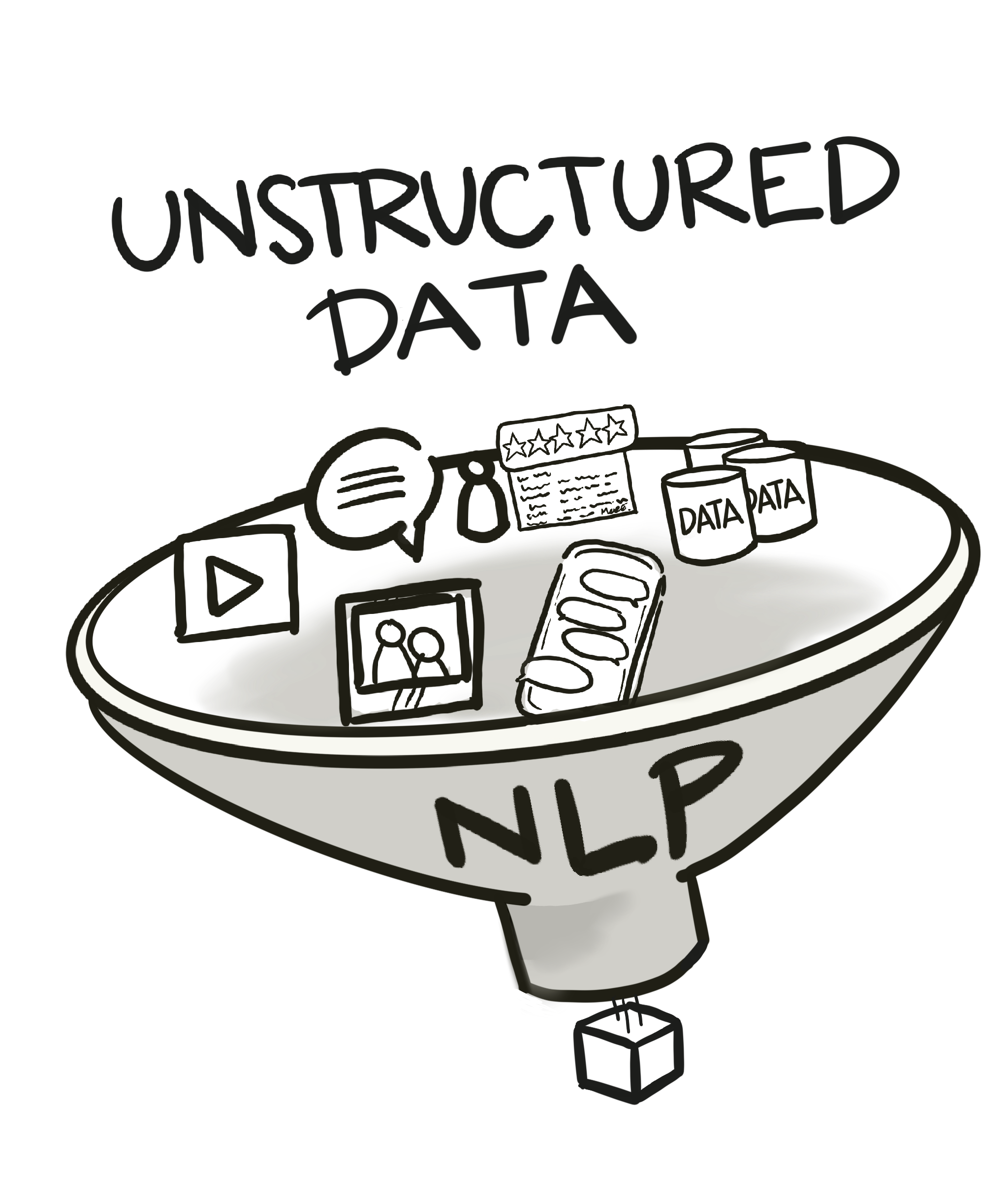How to use AI Natural Language Processing (NLP) to innovate your business
So what is Natural Language Processing (NLP) simply put it is how AI understands and makes sense of the information it has access to in supporting your business to derive insights, act on customer needs and improve your products and services.
Industry experts estimate that 80-90% of the data in an organisation is unstructured, and a vast majority is in the form of text data. More importantly, the amount of unstructured data is expected to grow faster than structured data.
I was watching Microsoft's launch of OneDrive 3.0 yesterday, and you can see how they are using AI to support their customers in managing the ecosystem in which information is being stored, categorised, searched for and managed.
Understanding the differences between “Structured” and “Unstructured” data
Structured data refers to data that can neatly fit into a spreadsheet. Customer records are an example of structured data.
Unstructured data refers to data with no clear format. It consists of videos, audio, free-format textual data and sensor data.
NLP can work across all these data sources seamlessly within the parameters set for the AI to perform defined tasks.
An NLP deep-dive for Business Application
Today, there are many areas in business where NLP can be applied, but in this post, we will explore four common types. Read to the end for business application of these.
Textural Classification
Also known as document categorisation, it is where NLP assigns labels to documents and textual content.
It does this by reading the content and automatically defining a categorisation. This is crucial for many business problems, for example, you could use it to organise all your company's business documents by applying appropriate tags such as product roadmap, lending, UX design… In my experience working at the National Australia Bank (NAB), we could have used this for our Confluence – collaboration tool.
News - being naturally curious – I thought it could not be long before this is used for Confluence, and just like that, there is a new feature that can be used with the Atlassian – AI assist for Confluence. Okay, back to the blog…
You can also use Text Classification to flag inappropriate content in public forums to keep conversations safe. This is already used on platforms like LinkedIn, which uses Test Classification to flag inappropriate profiles ranging from profanity to advertisements for illegal services.
Sentiment Analysis
Automatically summarises emotions in freeform text, allowing you to predict the sentiment orientation in customer feedback like reviews or tweets such as positive, neutral or negative. It is not limited to this; you can go more granular to predict elements like anger, joy and sadness.
You can imagine its popularity in allowing businesses to understand customer perception towards your brand, products, services or marketing campaigns. This information will support organisations to better understand their customers and fix issues that are making customers unhappy.
I can hear designers and product managers asking, “How do we get access, and when can we start to use this!?!” It will be able to support so many aspects of our practices.
Information Extraction
Is a process where AI uses NLP to identify and pull out information from textual data. This helps surface nuggets of important information buried within large amounts or blocks of text. Designers, can you imagine how this would help you in your research, I can recall pouring through unstructured data to apply thematics to surface customer insights, which took weeks, if not months and before we had digital whiteboards huge walls.
By automating this process with NLP, you can extract the information in a matter of seconds and minutes.
Google uses this to read emails and offers to add events, such as concerts and restaurant reservations, to your calendar today.
As someone who loves my Legal series, I could see this reducing those scenes where they have huge boxes dumped off and spend days pouring through them as part of their discovery process.
Conversational Agents
This is where we see a lot of interest in NLP's capability for business application, as it directly correlates to activities performed today and would provide both short and long-term gains once implemented. By replacing existing non-AI Chatbots with a greater ability to resolve at the first point of contact, you would see a reduction in the need for LifeChat or to divert your customers to other non-digital channels.
These AI agents or AI Chatbots are programs that can communicate with users in natural language with text, speech or both. They can also interpret images if required. And it is doing this today, with organisations using this to support their customers in simple and even complex interactions.
The interactions can be in the form of rolling conversations, support complex language understanding, and, in some cases, even translation between languages. Using their Sentiment capability, they can combine with other components I mentioned here to provide empathetic-like responses.
Other forms of Conversational agents might already be supporting you in your homes today with Siri, Alexa and Google Assistants. They are designed to complete actions within their ecosystem, provide information and complete tasks on your behalf. My exposure is with Siri, and today it can search for information, tell me the weather inside and outside my home with the addition of the HomePod, and even manage my light settings. We will see even more opportunities for these agents as the Smart home advances. Like many of these things, we find people's adoption amplifying, especially where it makes their lives easier, simpler, and faster.
How these can support your customers
If you think about it, these concepts could be applied to many things we do in business today. It could:
Act as the first point of contact for customers, and as it operates 24/7 and 365 days a week, it could take a lot of interactions out of more expensive channels to operate. As a service front door, it will reduce call centre volumes and if required could route customers to an area for second-level support. It will also provide the receiving customer agent with details about why and context about the customer and do this consistently and tirelessly. I am looking forward to a world where there is no more Press 1 for Sales, Press 2 for Customer support, and Press 3 to hear these options again…
It is being used today for insurance claim handling to assess damages visually and initiate the claim process, and this is being done for retail returns and even car and house claims. I was talking with one of Australia's largest General Insurers, and its ability to tirelessly process multiple assessments at a time, especially during major events like fire or flooding, would allow for customers to be served and supported at a moment that really matters to them and their families.
It can be used in medical applications for screening triage and, in some cases, with greater accuracy, and it could be done remotely by opening its application to remote areas. It could use its ability of rolling conversations to interact and support the application of care until assistance arrives, all whilst interpreting sentiment in the interaction.
They can be a translator service, allowing you to extend your reach and support customers accessing and using your services globally.
So, there you have it, four components of NLP that could support your business and a few practical examples thrown in for good measure. These come together in an AI Business Strategy, with some being purely rule-based and leaning into more modern NLP applications that rely on Machine Learning and Deep Learning Methods that I will cover in later posts. There are many other components to NLP, but these are more commonly used and generally easier to implement.
Conclusion and Next Steps
Natural Language Processing (NLP) is a transformative force that can empower your business to unravel valuable insights from the sea of unstructured data. By harnessing NLP's capabilities in Textual Classification, Sentiment Analysis, Information Extraction, and Conversational Agents, businesses can drive efficiency, enhance customer experiences, and make informed decisions like never before.
Your journey into the world of NLP starts here. Explore its potential, understand how it can revolutionise your industry, and envisage how your business can benefit. If you're ready to dive deeper and integrate NLP into your business strategy, I'm here to guide you every step of the way. Reach out to me to embark on this transformative journey towards AI-powered success.
Let's unlock the full potential of NLP and steer your business towards a future of intelligent insights and enhanced customer experiences. Please get in contact with me to learn more or access my services.



